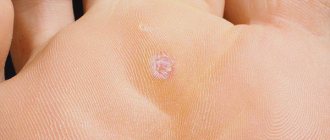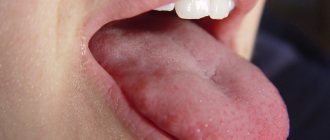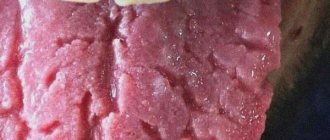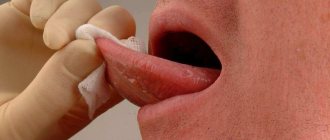The tongue is a muscular organ that responds to the occurrence of any pathologies in the human body by changing color, the appearance of plaque, ulcers, and fluid-filled cavities. A number of formations and minor irritations can disappear without the use of medications, with the help of rinses and compresses. Blisters on the tongue can provoke the development of serious diseasesTherefore, their treatment requires mandatory medical consultation.
Signs of normality and pathology
The tongue is a muscular organ that is responsible not only for our speech and perception of the taste of food, but also often signals problems occurring in the body. In its normal state it is pinkish, the tissue structure is homogeneous. The organ can be covered with a whitish coating (most often in the morning), or colored deposits from food: both types are easily removed with a brush or scraper.
In normal condition, the tongue is pinkish
If spots and blisters of different colors and in different quantities appear on the tongue, this indicates a negative impact on the tissue of external factors, or the occurrence of pathological processes and various diseases in the body1. In this case, the neoplasms can itch, burn, hurt, itch, burst, become covered with a crust and a foul-smelling coating.
We will analyze all the main reasons further.
In what cases is it better to consult a doctor?
You should consult a doctor if a large number of blisters appear . If 1-2 small bubbles are observed, you can try to provide first aid and wait. If in the near future the number of bubbles increases or those that previously appeared increase, then you need to go to a specialist.
Blisters do not appear without a reason, especially when it comes to a child. If the cause is chickenpox, the doctor will prescribe medications to treat the oral cavity. The same applies to thrush, but it needs to be treated comprehensively.
ATTENTION! Contact your dentist, dermatologist, or physician. You can treat your problem either in a public clinic or in a private family medicine clinic.
Dental problems
Wondering how blisters on the tongue are related to dental pathologies? Incorrect bite, the presence of chipped and damaged teeth, poorly fitted orthopedic and orthodontic structures can lead to periodic and systematic injury to the muscular organ and its biting. In most cases, after an injury, a single blister forms on the tongue, which, depending on the depth and severity of the injury, sometimes becomes filled with blood.
In fact, dental pathologies most often lead to tongue injuries in adults, when red, bleeding wounds and blisters appear on the tissue. But in children, the appearance of rashes on a muscle organ is often caused by a restless lifestyle: while playing, children fall, hit themselves, and can bite their tongue until it bleeds.
After an injury, a blister may form on the tongue, which is sometimes filled with blood.
Sometimes it’s not a traumatic factor at all. Formations on the tongue can appear under the influence of pathogenic bacteria that live in plaque, which is abundantly deposited on the surface of the teeth and gums. This happens if a person does poor oral hygiene and only for show, does not treat in a timely manner and causes caries, pulpitis, gingivitis, and periodontitis.
“One time I began to notice that some kind of bubble with blood inside came out on my tongue. It looked like something had damaged the tissue. I went to the dentist, he said: yes, there are problems in my mouth. I corrected all the flaws and restored some of my teeth. But this infection did not go away, but seemed to begin to grow even more. Then, reluctantly, I went to a therapist, who, after an examination, urgently sent me to an oncologist. He diagnosed him with hemangioma. It’s good that this infection turned out to be benign, it was removed, and the prognosis is favorable. Doctors said it could have been caused by simply biting the tongue while the teeth were in poor condition, even before going to the dentist.”
Evi, review from woman.ru
Thermal and chemical burns
Pathology may indicate that a person has consumed too hot foods and drinks. The problem often occurs among smokers, as cigarette smoke can lead to irritation and damage to delicate tissues.
A burn can be caused by eating sour and spicy foods, after which a feeling of “on edge” often appears on the tongue. The problem is also caused by the independent use of various drugs, as well as aggressive agents in folk recipes for the treatment of diseases of the oral cavity (hydrogen peroxide, iodine, potassium permanganate, garlic, alcohol).
A blister may occur as a result of a burn.
As a rule, in such situations, the very tip of the tongue becomes blistered.
Traditional methods
From folk recipes, to relieve inflammation, rinsing with a decoction of chamomile and calendula will help. Or it could be a weak solution of furatsilin, potassium permanganate. You need to rinse your mouth as often as possible. The procedure is carried out after meals, before bed and after waking up. On average 4 times.
Compresses made from gauze with agave juice also have a good effect. These procedures must be carried out 3 times a day.
If the rash does not disappear three days after treatment or appears again, you need to seek help from a doctor.
Candidal stomatitis
Many are accustomed to thinking that stomatitis caused by the Candida fungus virus makes itself felt only through ulcers and rashes that appear on the gums and palate. But in fact, its main symptom is a dense whitish or grayish coating of curd consistency on the tongue. If you try to remove such plaque, you will find blisters underneath that itch, hurt, and bleed. As a rule, small blisters are found around the perimeter of the tongue.
The photo shows candidal stomatitis
Often the disease is provoked not only by weakened immunity, dysbiosis and long-term use of antibiotics, but also by the presence of advanced dental pathologies and lack of proper oral hygiene.
"Chlorhexidine": instructions for use for mouth rinse
This is a cheap and universal antiseptic. Bottle with 100 gr. The product costs about twenty rubles. You can buy it at any pharmacy without a doctor's prescription. True, pharmacists often offer Miramistin, which is more expensive, but do not fall for the assurances that the effect of these solutions is completely identical. They differ from each other only in cost.
Instructions for use for “Chlorhexidine” for mouth rinse indicate that the drug has the following properties:
- stopping the development of infection;
- reducing the activity of pathogenic microorganisms;
- pain relief after tooth extraction;
- disinfection of the oral cavity;
- healing of pimples, inflammations, ulcers;
- acceleration of healing after damage to the tongue, gums, cheeks;
- treatment of sore throat and inflammation of the lymph nodes;
- reduction of swelling;
- accelerated tissue healing after oral surgery;
- reduction of hyperemia.
To rinse, dilute the concentrated preparation in a ratio of 1:5 with clean water. The first rinse should be a test: if the child does not experience excessive burning, then the procedure can be continued. Otherwise, the solution should be diluted by another third.
Herpes virus
A scattering of small blisters on the tongue (in any area) can also signal the development of a herpetic infection. In this case, the neoplasms look like transparent blisters filled with fluid or pus. A few days after their appearance, such blisters burst, and their contents enter the oral cavity and contribute to the spread of infection to healthy tissues. Very painful ulcers appear at the site of the formations, causing discomfort while eating food.
Pathology may be herpes
Prevention
The main rule of oral health prevention for children and adults is hygiene:
- Brush your teeth twice a day. Change your toothbrushes 3-4 times a year. Use dental floss and mouthwash.
- Stop smoking.
- Limit your alcohol intake.
- Remove processed foods and snacks from your diet.
- Wash your hands thoroughly, several times a day.
Eat more natural products: vegetables, fruits, after washing them in running water.
Allergic dermatitis
When small blisters appear at the root of the tongue, they are red in color and itch very much, this usually indicates the development of an allergic reaction to food, personal hygiene products (inappropriate brush, mouthwash), and medications.
The photo shows an allergy on the root of the tongue
In such conditions, the muscular organ swells, and the lymph nodes become slightly swollen. In advanced stages, cracks, crusts and erosions can form, and rashes can appear not only in the mouth, but also around the lips and even on the face.
Upper respiratory tract diseases
If red round blisters appear on the tongue closer to the throat, the throat itself swells, itches and becomes inflamed, the body temperature begins to rise, the breath becomes foul, and the person cannot eat without pain, then based on these symptoms one can suspect a sore throat and pharyngitis. With pharyngitis, the voice “sits down” and it becomes very difficult to talk.
Throat diseases can cause pathology
A similar symptom is recorded in the following conditions: syphilis, tuberculosis, HIV, oncology, vitamin deficiency, diabetes mellitus, pemphigus, angisarcoma.
Infectious pathologies
Almost all children aged 3-7 years get chickenpox, during which you can easily find blisters not only on the body, but also in the mouth, usually located at the root of the tongue, as well as rashes closer to the throat, filled with a yellowish liquid. The disease can in rare cases be found in adults, but the older generation suffers it much more severely, almost always with high body temperature and severe malaise.
With chickenpox, pimples can be not only on the body, but also on the tongue
There is another childhood pathology - scarlet fever. This disease manifests itself in almost the same way as chickenpox, but it also causes swelling of the larynx.
How you can help yourself and others
So, you or your child have blisters on the root of the tongue, closer to the throat, or in other areas of the muscle organ. Confused about what this means and how to proceed? We'll tell you.
Don't leave the problem unattended
First, identify the accompanying symptoms. If the pathology is accompanied by an increase in body temperature, severe pain, inability to eat food, or general weakness, then you need to call a general practitioner. If there is no fever and the blisters persist for longer than 2-5 days, it is important to visit a specialist yourself. If the rashes are systematic (if they are not one-time, but appear at certain intervals again and again), it is better to visit the dentist, because often the problem indicates an incorrect bite and others dental pathologies.
Until you have consulted a doctor, be sure to treat damaged tissue
You can use classic and, most importantly, time-tested disinfectants: “Chlorhexidine”, “Furacilin”. For this purpose, children and pregnant women are recommended to use Miramistin, a decoction of chamomile, and a soda solution is also suitable. This will help relieve inflammation and soreness, reduce the risk of infection and spread to healthy tissue, and speed up the healing process.
Rinsing with disinfectants will help in treatment
If a muscle organ is sore, it is allowed to take painkillers and non-steroidal anti-inflammatory drugs from a home medicine cabinet. For example, Nurofen, Ibuprofen.
You can not only rinse your mouth with the products listed, but also treat the inflamed area with sprays like Hexoral, Tantum Verde, and Lugol. Especially if the blisters are located closer to the throat. The listed drugs will not only help relieve inflammation, but will also have an analgesic effect.
It is important to thoroughly clean the oral cavity and the tongue itself due to plaque
By removing food debris from your mouth, you deprive pathogenic bacteria of a favorable environment for reproduction and thereby reduce the likelihood of developing complications. But the effect on the muscular organ must be gentle and careful. You should not rub or scrape your tongue or actively press on it, as this can cause irritation and damage the tissue even more.
Don't brush your tongue too hard or too thoroughly
Under no circumstances should you touch the rash with your hands or foreign objects, comb it, or try to open it or squeeze it out yourself.
It is necessary to exclude some dishes and drinks from the menu
Pain and itching can become even worse if you consume citrus fruits, salty foods and spicy seasonings, excessively hot and carbonated drinks, whole hard vegetables and fruits.
During the period until the disease has completely subsided, it is recommended to drink plenty of fluids, which helps to increase the production of saliva, which is an excellent natural antiseptic.
Stop using common things
This should be done if you suspect viral or fungal diseases that cause blisters on the tongue. Otherwise, your loved ones and those closest to you, with whom you share a towel, dishes, cosmetics, and cutlery, may contract the infection.
Remember that you can only talk about home treatment for a blister if it is not a specific symptom of one of the diseases.
Notice
: Undefined variable: post_id in
/home/c/ch75405/public_html/wp-content/themes/UltraSmile/single-item.php
on line
45 Notice
: Undefined variable: full in
/home/c/ch75405/public_html/wp-content /themes/UltraSmile/single-item.php
on line
46
Rate this article:
( 5 ratings, average: 4.20 out of 5)
language
- Lutskaya I.K. Systematic and independent diseases of the tongue. // Medical news. – 2015.
Expert “To eliminate the factor that causes the appearance of traumatic blisters on the mucous membrane of the tongue, the patient may have to undergo orthodontic treatment, think about prosthetics or replacing old structures with new ones, and restore teeth using different restoration methods. It is also very important to perform professional oral hygiene and treat teeth and gums, since various pathogens from plaque and advanced diseases can aggravate the situation and provoke an inflammatory process.” Dental hygienist Victoria Nikolaevna Kashaeva
Consulting specialist
Tarabanovskaya Marina Igorevna
Specialization: Dentist therapist, periodontist Experience: 9 years
First aid
If it is not possible to see a doctor in the near future, take measures designed to stop the spread of blisters over the entire surface of the mucous membrane (on the gums, on the palate, on the inside of the lips and even in the throat) and eliminate pain:
- It is necessary to rinse your mouth with disinfectant solutions without alcohol, as it can increase irritation. Acceptable antiseptics : “Chlorhexidine”, “Miramistin”, warm decoction of chamomile or calendula, furatsilin solution;
- Warm rinsing with water (+ soda, + salt) or painkillers will help eliminate the painful sensation
REFERENCE ! Carefully study the contraindications and consult your doctor. to contents
Comments
A pimple appeared on my tongue and it was very itchy. Maybe I should drink something for my allergies? Or go straight to antibiotics?
Maria (12/11/2020 at 12:18 pm) Reply to comment
- If you suspect an allergy, it is still permissible to take an antihistamine (Erius, Zodak, Suprastin). But antibiotics, antifungal and antiviral tablets should never be used without the prescription of a specialist. Although the symptoms of conditions that cause blisters on the base of the tongue or closer to the throat are similar, each is treated differently. So, if you start taking antifungal medications for a herpetic infection, you can further aggravate the situation.
Editorial staff of the portal UltraSmile.ru (12/16/2020 at 09:12) Reply to comment
It’s good if the dentist paid attention to the pathology and advised you to see a therapist. Can a dentist, seeing a problem, recommend donating blood for specific types of diseases?
Dasha (12/18/2020 at 10:00) Reply to comment
Herpes is half the problem, or if you suddenly and carelessly sip hot tea or boiling water. How do you get these blisters out? Firstly, the tongue hurts and eating will be uncomfortable and painful.
Yura (12/18/2020 at 11:38 am) Reply to comment
If there is a minor allergy that causes blisters on the tongue, does it make sense to choose antihistamines? I have noticed this phenomenon in myself more than once, it slowly goes away.
Ruslan (12/18/2020 at 11:42 am) Reply to comment
I recently changed my toothpaste and noticed a rash on my tongue. Could they be a reaction to toothpaste? Please advise what to do in this case, maybe not to risk it and replace it with another?
Lena (12/18/2020 at 11:44 am) Reply to comment
Should you go to an ambulance with this problem? Maybe the doctor will advise something, prescribe some medications? Is it really possible to self-medicate if such a problem suddenly arises?
Masha (12/18/2020 at 11:45 am) Reply to comment
Not long ago I took ice cream out of the freezer, ate it and noticed that blisters appeared on my tongue after eating it. Is this a reaction to dyes and composition or an allergy to cold, tell me how to find out?
Leonid (12/18/2020 at 11:46 am) Reply to comment
Blisters periodically appear on the child’s tongue, but just as mysteriously they go away on their own. After a while this repeats itself. Tell me, could this be due to problems with the gastrointestinal tract?
Anna (02/05/2021 at 09:33) Reply to comment
Wow, there are so many reasons, you won’t immediately understand why, in any case you need to go to a specialist, and you probably won’t figure it out without tests. And if they appear and disappear on their own, is it worth going to the doctor?
Alena (02/05/2021 at 10:01 am) Reply to comment
Sometimes small blisters or pimples appear on the very tip of my tongue, I don’t know what they’re called exactly. They cause slight discomfort, but gradually disappear. There seem to be no health problems. What could it be? Do I need to go to a specialist about this?
Ekaterina (02/05/2021 at 10:03 am) Reply to comment
Tell me, a couple of days ago, my tongue started to burn, as if it had been burned by boiling water, today I noticed small blisters, is this an allergy to something?
Valeria (06/08/2021 at 19:37) Reply to comment
Write your comment Cancel reply
Natural Remedies for a Healthy Tongue
Some natural remedies can help speed up the healing of tongue blisters:
- pay attention to your diet , which should be rich in vitamin C, which strengthens the immune system. It is helpful to eat soft and creamy foods such as yogurt, which will not worsen oral injuries.
- After brushing your teeth, it is useful to gargle with water and baking soda or a disinfectant solution.
- Sometimes you can rinse your mouth with green tea essential oil dissolved in water. Green tea has high bactericidal power.
- Coconut essential oil or aloe vera are moisturizing and can be used to relieve the discomfort and pain of tongue sores.
These remedies are effective in relieving symptoms , but cannot replace drug treatment , which will be prescribed by a doctor after a thorough analysis of the problem.
Herbal decoction
This decoction will be useful for children who do not yet know how to rinse their mouths, but can only drink the liquid offered. To prepare, it is enough to prepare two components - rose hips and chamomile .
These herbs have anti-inflammatory and antimicrobial effects, and if many drugs have a number of side effects, then the decoction can be drunk without fear for the baby’s health. The main thing is that there are no allergies.
You need to add 2 tablespoons of chamomile and rose hips to boiling water.- Mix well and close the jar with a lid.
- Wait an hour.
- During this time, the broth will infuse; it must be carefully drained.
You need to give your child 3 teaspoons, but a lot depends on age . 2 teaspoons – dosage for a 4 year old child. For older children, you can add half a spoon each year.
Aloe or calandoe
Aloe is great for quickly healing mouth blisters .
It can be peeled, crushed and added to water. This infusion is either drunk orally or serves as a mouth rinse.
You need to drink a little aloe - 2 teaspoons, and before the child swallows the drink, it is better to hold it in the mouth.









